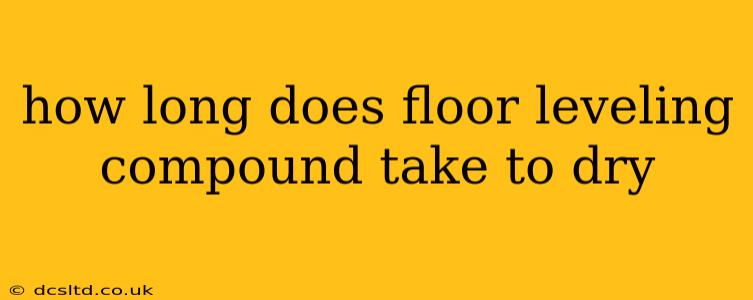Leveling your floor can dramatically improve the look and feel of your home, creating a smooth, even surface for flooring installation. But before you start admiring your new, perfectly flat floors, you need to know how long the leveling compound takes to dry. This isn't a one-size-fits-all answer, as drying time depends on several factors. This comprehensive guide will explore these factors and provide you with the information you need to plan your project effectively.
What Factors Affect Floor Leveling Compound Drying Time?
Several factors influence how long your floor leveling compound needs to dry completely. Understanding these factors is crucial for accurate project planning and preventing potential problems.
1. Type of Leveling Compound:
Different leveling compounds have different drying times. Self-leveling compounds, designed to flow smoothly and create a perfectly even surface, generally dry faster than other types. However, the specific brand and formulation also play a significant role. Always check the manufacturer's instructions for the precise drying time recommended for your specific product.
2. Thickness of the Application:
The thicker the layer of leveling compound you apply, the longer it will take to dry. Thin coats dry much faster than thick ones. It's always better to apply multiple thin coats rather than one thick coat to ensure proper drying and prevent cracking.
3. Ambient Temperature and Humidity:
Temperature and humidity significantly impact drying time. High temperatures and low humidity accelerate drying, while low temperatures and high humidity slow it down considerably. Ideal conditions are usually a temperature between 65-75°F (18-24°C) and a humidity level below 60%.
4. Ventilation:
Good ventilation is crucial for proper drying. Adequate airflow helps to remove moisture from the compound, speeding up the drying process. Ensure proper ventilation in the room during and after application.
5. Substrate Material:
The material of your subfloor can also affect drying time. Porous substrates like concrete will absorb some of the moisture from the compound, potentially slowing down the drying process. Non-porous substrates will generally lead to faster drying times.
How Long Does it Typically Take?
While exact drying times vary significantly, here's a general guideline:
- Self-leveling compounds: Typically dry to the touch in a few hours, but may require 12-24 hours or more to fully cure before further work can begin. Always refer to the manufacturer's instructions.
- Other leveling compounds: These might take longer, often requiring 24-48 hours or even longer for complete drying, especially for thicker applications.
H2: How Can I Tell if My Floor Leveling Compound is Completely Dry?
Determining if your floor leveling compound is completely dry isn't just about touching it and seeing if it feels dry. Complete drying involves the complete evaporation of moisture and the full curing of the compound. Here are some indicators:
- Visual inspection: The surface should appear smooth, even, and free of any visible moisture.
- Touch test: The surface should be firm and dry to the touch, without any stickiness or softness.
- Moisture meter: For a more precise measurement, a moisture meter can be used to check the moisture content of the compound. This is especially helpful for critical applications.
H2: What Happens if I Don't Wait Long Enough Before Applying Flooring?
Applying new flooring too soon after leveling can have serious consequences:
- Delamination: The new flooring might not adhere properly to the still-wet compound, leading to delamination (separation) over time.
- Damage to flooring: Moisture from the compound can damage certain flooring materials, especially those sensitive to moisture like wood.
- Uneven surface: The still-wet compound could cause unevenness in the new floor, resulting in an unsatisfactory finish.
Always allow the compound to fully cure before proceeding with the next step in your flooring project.
H2: Can I speed up the drying process?
While you can't drastically alter the chemical drying process, improving ventilation and maintaining a suitable temperature and humidity will help expedite drying. Using fans to improve air circulation can be beneficial. However, avoid using heaters directly on the compound, as this may cause cracking.
Remember, always prioritize safety and follow the manufacturer's instructions precisely for the best results. If you have any doubts, it's always better to err on the side of caution and wait longer before applying your new flooring. This will ensure a long-lasting, beautiful finish to your flooring project.
